THE CLASSIC HORROR FILM
By Jeffrey-Baptiste Tarlofsky
By Jeffrey-Baptiste Tarlofsky
Lesson 9 consists of six video lectures and transcripts of those lectures, and three film excerpts. Start with excerpt #1 from Dracula and continue down the page in sequence until you reach the end of the lesson.
レッスン9は6本のビデオレクチャー(レクチャーのテキストがビデオレクチャーの下に記載されています)と3本の動画で構成されています。
このレッスンは、ページをスクロールダウンしながら最初から順番に動画を見たりテキストを読んでください。
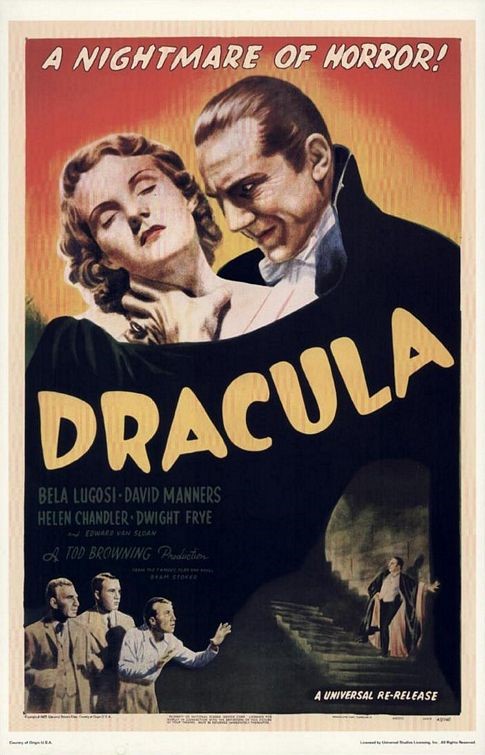
Directed by Tod Browning
Produced by Carl Laemmale, Jr.
Cinematography Karl Freund
Written by Garret Ford and Tod Browning (Based on the novel by Bram Stoker as well as the stage play by Hamilton Deane and John L. Balderston)
Starring Bela Lugosi, David Manners, Dwight Frye, Helen Chandler, Edward van Sloan
Budget: Approximately 355,000
Part 1 – Carl Laemmle, Jr. bought the rights to both the novel, Dracula, and the very successful Broadway play, Dracula.
The way was clear for Universal to make the film. However, Universal could not afford another failure. The bitter disappointment of the musical Broadway in 1929 meant that Carl Laemmle Jr. would have to modify the “Thalberg Formula” because he did not have the resources to launch another million or million-and-half-dollar movie like The Hunchback of Notre Dame, Phantom of the Opera or The Man Who Laughs. But Laemmle believed that he did not need to. The German expressionist style Paul Leni had used in the two films he made for Universal, The Cat and The Canary and The Man Who Laughs, seemed to perfectly suit Dracula and it was the inexpensively made Cat and The Canary which had made money for the studio while the gigantic Man Who Laughs had lost money. This convinced Laemmle that style, (especially German Expressionist style), not gigantic and expensive sets and costumed extras could create exactly the atmosphere he wanted for Dracula. Paul Leni had shown he could direct a film on a low budget, but with exactly the right atmosphere. But just as Laemmle was buying the right to Dracula, tragedy struck. Paul Leni, one of the geniuses of German Expressionism, died in 1929 from an infection caused by a bad tooth!
The death of Paul Leni certainly made Laemmle’s job more difficult. Who could he possibly get to direct Dracula with the right atmosphere? The obvious choice was none other than F.W. Murnau, the man who had directed Nosferatu! Murnau had immigrated to America in 1926 and was working for Fox studios. But there were many problems trying to use Murnau. The whole reason Murnau had left Germany was because his last German film, Faust (1926), a true masterpiece of German Expressionism, had cost so much to make that the studio which produced it had almost gone bankrupt.
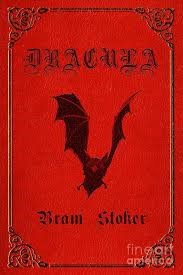
Image #1 The Novel
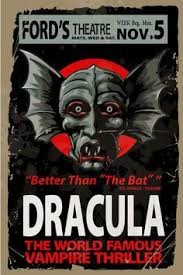
Image #2 The Play

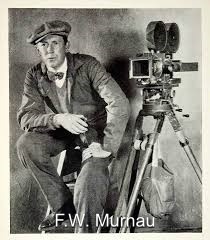
F.W. Murnau was no Paul Leni, who could be counted on to deliver a film on budget. Murnau’s last two films for Fox, Four Devils and City Girl had both gone over budget and had other problems as well. Moreover, fed up with studio restrictions, Murnau had started his own small production company and left for the South Pacific in 1930 to make his great semi-documentary film, Tabu. So, he wasn’t even in America at the time Laemmle needed a director for Dracula. There was no way Laemmle could use him.
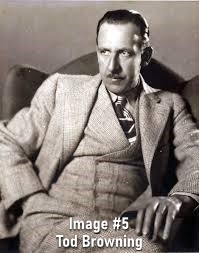 Part 2 – Then Carl Laemmle, Jr. had a brainstorm. Perhaps he couldn’t find another German Expressionist director, but he certainly could hire a director who had extensive experience filming the “human tragedy” types of films like The Hunchback of Notre Dame and The Phantom of the Opera. He hired Tod Browning!Browning was a very experienced director, but more important than that, he was Lon Chaney’s close friend and associate. Lon Chaney and Tod Browning, “the Gruesome Twosome”, were first paired as a team by producer Irving Thalberg at Universal Studios in 1919 before either was famous. Thalberg teamed them again in 1925 in a film called The Unholy Three, a “human tragedy” story about circus performers turning to theft and murder. Most of the films Chaney and Browning made were of this type, not really what we would today call true horror movies. The exception was London After Midnight (1927) in which Chaney created another one of his one thousand faces, that of the grinning vampire which we have already talked about when we compared Chaney’s make-up design to that of Jack Pierce’s for The Man Who Laughs.
Part 2 – Then Carl Laemmle, Jr. had a brainstorm. Perhaps he couldn’t find another German Expressionist director, but he certainly could hire a director who had extensive experience filming the “human tragedy” types of films like The Hunchback of Notre Dame and The Phantom of the Opera. He hired Tod Browning!Browning was a very experienced director, but more important than that, he was Lon Chaney’s close friend and associate. Lon Chaney and Tod Browning, “the Gruesome Twosome”, were first paired as a team by producer Irving Thalberg at Universal Studios in 1919 before either was famous. Thalberg teamed them again in 1925 in a film called The Unholy Three, a “human tragedy” story about circus performers turning to theft and murder. Most of the films Chaney and Browning made were of this type, not really what we would today call true horror movies. The exception was London After Midnight (1927) in which Chaney created another one of his one thousand faces, that of the grinning vampire which we have already talked about when we compared Chaney’s make-up design to that of Jack Pierce’s for The Man Who Laughs.
Chaney’s grinning vampire In London After Midnight is important because this semi-comical vampire gives us a clue as to how Lon Chaney might have played the grandfather of all vampires, Dracula. We already know that Chaney made it a rule never to use the same make-up twice so it seems quite likely that he would have come up with something completely different looking if he had played Dracula. But even more important than the make-up would have been how Chaney chose to portray the character. Would he have played Dracula as a tragic character, an evil one, an unfortunate one? One thing would have been certain. If Chaney had played Dracula, he would have made the character wholly his own regardless of the script or director. No writer could ever control what Chaney did and Tod Browning did not so much direct Chaney as he encouraged him to do what he wanted to do.
Laemmle’s true reason for hiring Browning to direct Dracula was to use him as bait to lure Lon Chaney back to Universal. Of course, Universal could not afford to pay Chaney what M.G.M paid. But Laemmle knew that money was not what most interested Lon Chaney. Chaney was obsessed with playing challenging roles and receiving praise from the critics and the public. Even though all his films for M.G.M had been successful financially, none of them ever achieved the critical or popular success of his Hunchback of Note Dame and Phantom of the Opera. Moreover, Chaney knew that none of his M.G.M characters came close to being as great as his Quasimodo or his Erik. By offering Chaney Dracula, Laemmle knew he was offering Chaney a chance to challenge himself and create his greatest character. Moreover, this time Chaney would be working with his close friend and creative partner, Tod Browning. Chaney simply could not refuse! But Chaney never got the chance to refuse because, as you know, Lon Chaney died very suddenly in 1930 from lung cancer at the age of only forty-seven. You might be wondering if Dracula had a curse on it with Laemmle’s first choices for both director and star dying within a year of each other.
Part 3 – Two out of the three elements of the “Thalberg Formula” were now impossible to use in making Dracula. There would be no elaborate and gorgeous historical sets with thousands of costumed extras because there was no money for those things, and there would obviously be no Lon Chaney, either. What was left was the novel, which seemed to be a human tragedy of the Hunchback of Note Dame, Phantom of the Opera, Man Who Laughs type. However, a closer reading would have revealed that the character Dracula was really nothing like Quasimodo, Gwyplaine or even Erik. We will talk much more about this later.
Laemmle also had a veteran director in Tod Browning, one who knew exactly how to direct these so called “human tragedy” films. But Tod Browning was inconsistent. Sometimes he made good films, and sometimes he didn’t. The reason for this was that Browning suffered from periodic bouts of severe clinical depression. Depression was not well understood in the 1920s and 1930s and there was no effective medication to treat the illness. It was not even understood to be a disease by many doctors. When Browning experienced depression, he would frequently turn to alcohol as a kind of self-medication. It usually only made the depression worse and it also adversely effected his job performance. This was the real reason Carl Laemmle Jr. was able to hire him for Dracula in 1930. M.G.M. had not renewed Browning’s contract because of his drinking. But Carl Laemmle, Jr. believed in Browning and of course, he had also hoped Browning would lure Chaney back to Universal. To his credit, Carl Laemmle, Jr. did not replace Tod Browning after Chaney died.
But while Laemmle had a director, he did not have a Dracula. After Lon Chaney, the obvious choice for the role would have been Conrad Veidt who had played Gwynplaine. But the great German actor had left Hollywood after making The Man Who Laughs because Hollywood had gone over entirely to sound and he had never learned to speak English. Laemmle considered a long list of actors for the role, but his ultimate choice proved to be one of the best casting decisions he ever made. Laemmle simply chose the actor who had played Dracula on Broadway in 1927 and then toured with the production for another two years, Bela Lugosi. No one in the world knew the part better than Lugosi who had performed it on stage more than five hundred times. Moreover, Lugosi wouldn’t even have to learn a new script because in order to cut costs Laemmle insisted Browning basically film the Broadway play version of Dracula instead of adapting the novel directly. Laemmle was again remembering the success of The Cat and The Canary which was a Broadway play brought directly to film.
Some people assumed that Lugosi would be a poor substitute for Lon Chaney. But from the very first time you see him on screen, Lugosi is Dracula. In all the history of film there is no actor more closely associated with the character he plays than Lugosi is with Dracula. Dozens of actors have portrayed Dracula on film and stage since Lugosi, but none has ever come close to being Dracula the way Lugosi was. It was simply a stunning performance, one of the greatest in the history of horror, the equal of Chaney playing the Phantom. And we are now going to see the first eighteen minutes of the film in order to appreciate just how great Lugosi was.
Part 4 – We will never know what Lon Chaney would have done with the part of Dracula, but my own guess is that he would have created a memorable make-up for the character. But Bela Lugosi wore almost no make-up at all to play the part of Dracula. Tall, dark, handsome, with exquisite European manners and a thick Hungarian accent this was not at all the Dracula Tod Browning wanted. He had imagined filming Dracula almost entirely as a shadow or as being hidden in the shadows, but Carl Laemmle, Jr. would not take such an artistic risk. He told Browning to film it as close to the stage production as possible and in the stage play this was how Lugosi appeared.
This decision by Laemmle had a great effect on Browning. He deeply resented the interference.
Laemmle also insisted on using the same art director who had designed The Man Who Laughs, Charles D. Hall. This also took decision-making power away from Browning. Hall was far more limited with what he could do with the sets and art direction in Dracula because the film had such a small budget. However, the staircase in Dracula’s castle is wonderful and so is the staircase in Carfax Abbey where Dracula takes his female victim and finally kills Renfield. Charles D. Hall was wonderful with staircases!

Image #6 Bela Lugosi
Part 5 – On the other hand, the interior of the castle where Dracula entertained Renfield when they first met is an odd mixture of satisfying props and sets pieces such as the great fireplace and furniture, but with the walls behind appearing to be cheap construction wood rather than the stone of a castle. You never would have seen such shoddiness in The Hunchback of Notre Dame, The Phantom of the Opera or The Man Who Laughs.
There was also little that talented German cinematographer Karl Freund could without Tod Browning directing him and by the start of the production Tod Browning was both rapidly losing interest in the project and falling into one of his depressions. Browning felt that all the important decisions were being taken away from him. In fact, he was right.
The choice to use the play as the basis for the script did make the film much cheaper to produce, but it also took away many of the opportunities Browning would have had to create his own film if he had more control. Add to that Laemmle’s hiring of Lugosi and insistence that Dracula appear in the film as he had on stage, and the very limited budget and there was little left for Browning to do, although he could have been creative with his camera angles, movements and the lighting. He chose not to be. According to some people on the set, Karl Freund almost ended up directing the film because Browning was often too drunk to make decisions and was detached and uncommunicative during the production.
That is really quite sad.
There were numerous other problems with the film. The special effects were very low quality. The bats really did look like puppets on strings (which they were) and instead of a set with bizarre German Expressionist shadows and angles the castle we saw in excerpt #1 just looks like a painted theater set (which it was). In fact, the entire film feels like what it is: a stage play put on film. But even when the film does feel like a film, it feels more like a silent film than a sound film. Part of this is doubtless because Tod Browning had been a silent film director and this was only his third sound film. Browning was just one of those old Hollywood people who didn’t make the transition to sound very well. It didn’t help that there was no budget for an actual musical score for the film. Browning was forced to use recordings of classical music that generally didn’t match terribly well with the action in the film. Otherwise, there was no music at all in the film. There are also long parts of the film which are actually without either talking, music or sound of any kind. These turn out to be some of the best moments in the film, as when Dracula silently approaches a sleeping victim.

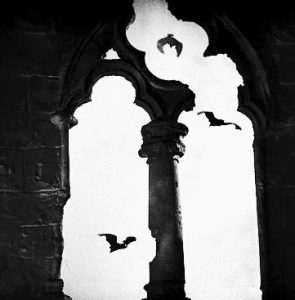
Part 6 – Overall, Dracula was in my opinion, a poorly made film. But, despite all the problems; the deaths of both Paul Leni and Lon Chaney, the very limited budget, the problems with Browning’s direction, the failure to pursue an Expressionist style in camera work, set design or lighting, the generally poor quality sets, low budget special effects, lack of sound or music….Dracula was a huge success for Universal. The film was budgeted at a very modest $355,000 (less than 25% of the budget for The Phantom of the Opera) but it turned a profit of over $700,000. Dracula was Universal Studios most profitable film of 1931 and it helped save the studio from bankruptcy.
Why was the film so successful? The one thing everyone remembers about the film itself is Bela Lugosi. He was nothing like any of the “monsters” seen in Universal’s previous “human tragedy” films. In fact, Carl Laemmle, Jr. himself sensed he had made something different with Dracula because when he was asked the standard question by the Hollywood press: “What kind of picture is this, Mr. Laemmle?”, he suddenly found himself saying, “This is a horror movie, boys”. And so, it was. Dracula was the first film ever to be called that.
This concludes lecture number 9.